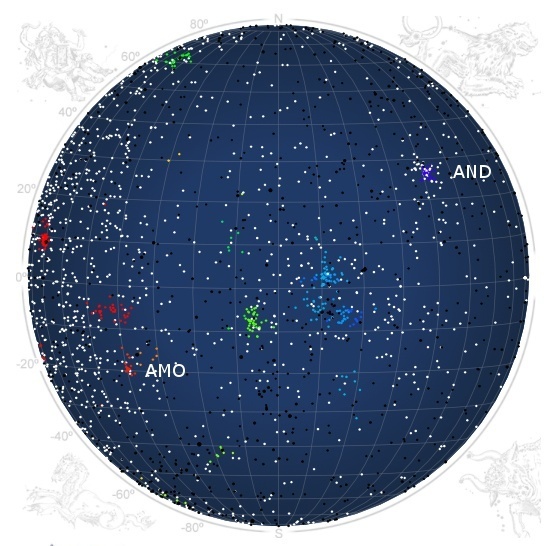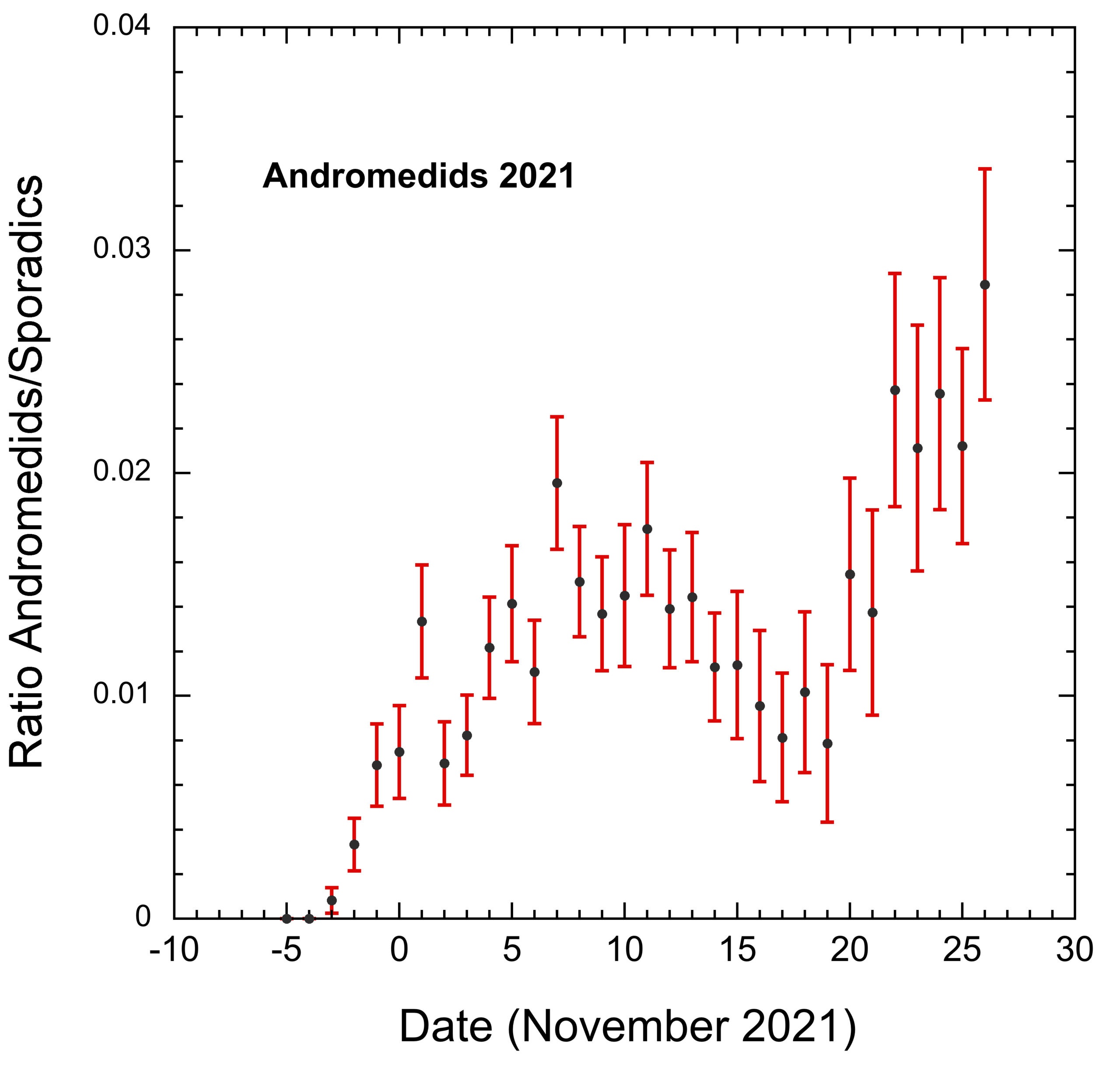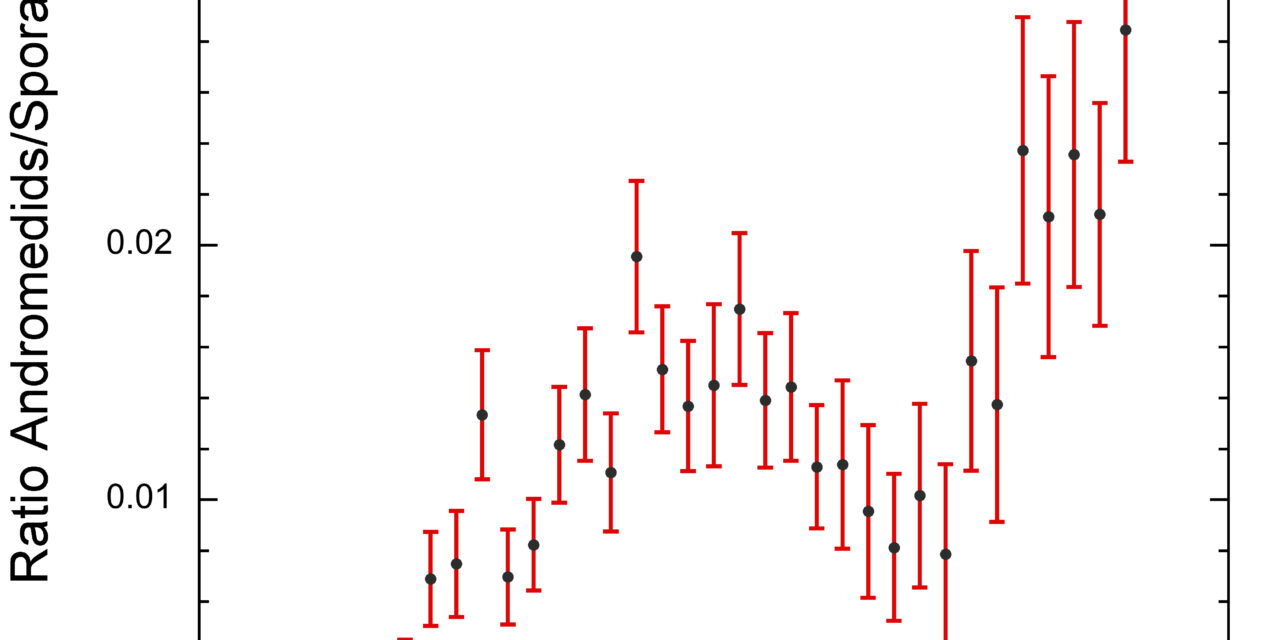Abstract: Northern hemisphere networks of the CAMS video orbit survey are detecting higher than expected rates of Andromedids (IAU shower 18) in recent days. Starting on November 20, 2021, rates have been significantly above the usual level and reversing a trend of decreasing Andromedid activity after November 9. On November 22, the geocentric radiant was located in the constellation Andromeda at R.A. = 25.2 ± 1.0, Decl. = +39.5 ± 0.7 degrees, while meteors entered the atmosphere with a slow geocentric speed Vg = 17.9 ± 2.2 km/s. Activity may continue for a few more days.
Introduction
The Andromedids are known from spectacular meteor storms in 1872 and 1885 that occurred shortly after the fragmentation of parent comet 3D/Biela. These storms appear to have resulted from normal comet (fragment) activity in the 1846 and 1852 returns, rather than from the breakup of 3D/Biela itself (Jenniskens & Vaubaillon, 2007). The shower was only briefly sighted in later years, but was recovered in photographic data in 1959 (Hawkins et al., 1959). More recently, it was found that the Andromedids are an annual meteor shower in low-light video data in early November (Jenniskens et al., 2016).
In most years, modest rates are detected in the first two weeks of November, but in some years the shower has episodes of enhanced activity in the final weeks of November and in early December. Andromedid outbursts in 2011 and 2013 were ascribed to the crossing of the 17th century dust trails from comet 3D/Biela (Wiegert et al., 2013; Brown, 2013). Based on that hypothesis, no enhanced activity was predicted for 2021.
Methods
The 2021 Andromedid activity was detected mostly by the northern hemisphere networks of the CAMS video-based meteoroid orbit survey, in particular by the networks in the BeNeLux (coordinated by C. Johannink and M. Breukers), Turkey (O. Unsalan), the United Arab Emirates (M. Odeh), Florida (A. Howell), Texas (W. Cooney, D. Samuels), Arkansas (L. Juneau), Arizona (N. Moskovitz), and California (J. Albers, T. Beck). Methods are described in Jenniskens et al. (2011).
The observations
The Andromedid shower (“AND” in Figure 1) was first detected on 2021 Oct. 28, when the radiant was near the ecliptic plane. The radiant slowly rose to higher ecliptic latitudes while rates increased until a broad maximum around Nov. 9, when on average one Andromedid was triangulated for every 68 sporadic meteors. After that, rates declined until a reversal occurred (c.f. http://cams.seti.org/FDL/ for dates of 2021 Nov. 20 to 22, see Figure 1).

Figure 1 – The radiant plot obtained by CAMS for 2021 November 22 ± 0.5.
Starting on Nov. 20, Andromedid rates have been significantly above the previous trend. On Nov. 22, there was one Andromedid triangulated for every 42 sporadic meteors and rates appeared to be rising (Figure 2).

Figure 2 – The preliminary activity profile of the Andromedids based on all low-light video data reported before November 23, 2021 (from: http://cams.seti.org/FDL/). This graph does not take into account varying coverage due to weather and technical issues. [Updated: 2021 Nov 26].
On that day, the geocentric radiant was located in the constellation Andromeda at R.A. = 25.2 ± 1.0, Decl. = +39.5 ± 0.7 degrees, while meteors entered the atmosphere with speed Vg = 17.9 ± 2.2 km/s (apparent speed Vinf = 21.0 km/s). Median orbital elements were:
- a = 4.5 AU;
- q = 0.828 ± 0.013 AU;
- e = 0.816 ± 0.128;
- i = 12.9 ± 1.2 deg;
- Peri. = 230.7 ± 1.0 deg;
- Node = 239.8 ± 0.1 deg (Equinox J2000.0).
The unexpected outburst will shed new light on the past activity of comet 3D/Biela. Activity may continue for a few more days, a faint echo of past meteor storms. Further observations are encouraged. It is interesting to note that the historic Andromedid storms from 1872 and 1885 radiated from R.A. = 27 deg and Decl. +45 deg on November 27, but no such high activity is expected this year.
Based on unusual Andromedid activity in prior years, the shower may remain visible until about December 6.
References
Brown P. (2013) Andromedid Meteors. CBET 3741, D. W. E. Green (ed.), Central Bureau for Astronomical Telegrams, pp 1-1.
Hawkins G. S., Southworth R. B., Stienon F. F. (1959) Recovery of the Andromedids. Astronomical Journal 64, 183–188.
Jenniskens P., Vaubaillon J. (2007) 3D/Biela and the Andromedids: Fragmenting versus sublimating comets. Astronomical Journal 134, 1037–1045.
Jenniskens P., Gural P. S., Dynneson L., Grigsby B. J., Newman K. E., Borden M., Koop M., Holman D. (2011) CAMS: Cameras for Allsky Meteor Surveillance to establish minor meteor showers. Icarus 216, 40–61.
Jenniskens P., Nénon Q., Albers J., Gural P. S., Haberman B., Morales R., Grigsby B. J., Samuels D., Johannink C. (2016) The established meteor showers as observed by CAMS. Icarus 266, 331–354.
Wiegert P. A., Brown P. G., Weryk R. J., Wong D. K. (2013) The return of the Andromedids meteor shower. Astronomical Journal 145, 70–81.





